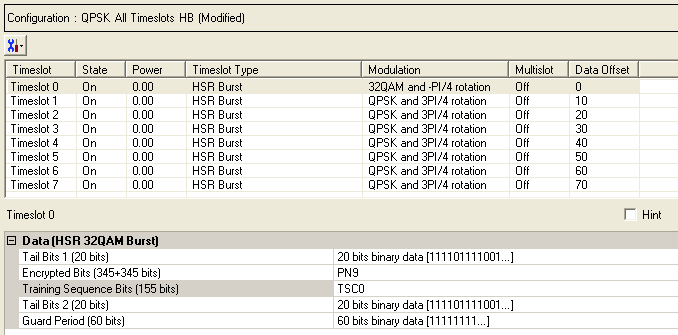
To open the Data node, click Data in the tree view. The figure below shows the Data node.
The timeslots shown below are set to show available timeslot types, not to show a typical test configuration.

|
1. Data (HSR 32QAM Burst) |
|---|
Click  to display a drop-down menu in which you can copy a timeslot configuration
from one timeslot to another.
to display a drop-down menu in which you can copy a timeslot configuration
from one timeslot to another.
Use the Data window to define the bits in the bursts. The cells displayed in the Data section are determined by the burst type (Timeslot Type) for the selected timeslot as defined in the Timeslots window. In the window shown above, Timeslot 6 is selected so the data cells provided are for setting up a Normal 32QAM Burst.

Default: X"F79CE"
Click the Details button  in this cell to open the Data Source Selection window. Enter 20 bits to
use in the first of the two tail bit segments of the HSR 32QAM burst.
See
in this cell to open the Data Source Selection window. Enter 20 bits to
use in the first of the two tail bit segments of the HSR 32QAM burst.
See  drop-down figure and description.
drop-down figure and description.
Default: PN9
Click the Details button  in this cell to open the
in this cell to open the  Data Source Selection
window.
Data Source Selection
window.
Select , or to use for the encrypted bits.
Select , to create an encrypted data string. (See the  drop-down figure.)
drop-down figure.)
Choice: TSC0 to TSC7 | User Defined Bits
Default: TSC0
Select to or to use for the training sequence bits.
Click the Details button  in this cell to open the
in this cell to open the  Data Source Selection
window.
Data Source Selection
window.
If you have selected from the  Pre-defined
Timeslot Configuration
dialog, the default training sequence corresponds to the timeslot number.
For example, the default for timeslot 0 is TSC0, the default for timeslot
1 is TSC1, and so on.
Pre-defined
Timeslot Configuration
dialog, the default training sequence corresponds to the timeslot number.
For example, the default for timeslot 0 is TSC0, the default for timeslot
1 is TSC1, and so on.
If you manually change a timeslot to an , the training sequence for that timeslot is automatically set to .
The training sequences are defined as follows:
|
TSC0 |
481 2902 5290 2400 0000 0025 2048 0000 2520 0012 |
|
TSC1 |
000 0948 0094 A400 0000 9024 0048 1294 8129 0252 |
|
TSC2 |
025 2000 1200 0129 0240 0480 0000 1294 8120 4A52 |
|
TSC3 |
4A5 2900 0094 A529 4812 9000 0902 4004 A409 0252 |
|
TSC4 |
024 0948 0004 A520 0240 04A4 0900 0000 0009 0252 |
|
TSC5 |
4A4 0902 5200 2409 0000 9481 294A 5290 0009 4A52 |
|
TSC6 |
024 0000 0004 8009 0252 9000 0900 1294 8000 4812 |
|
TSC7 |
024 0000 0090 0120 4800 04A5 2900 1200 0120 0252 |
Select to define custom training sequence bits. See the  drop-down figure.
drop-down figure.
Default: X"F79CE"
Click the Details button  in this cell to open the
in this cell to open the  Data Source Selection
window. Enter 20 bits to use in the second of the two tail bit segments
of the HSR 32QAM burst.
Data Source Selection
window. Enter 20 bits to use in the second of the two tail bit segments
of the HSR 32QAM burst.
Click the Details button  in this cell to open the
in this cell to open the  Data Source Selection
window.
Data Source Selection
window.
When the Timeslot Timing Mode is set to , the Guard Period is defined as follows:
If the HSR 32QAM Burst is in timeslot 0 or 4, the guard period has 60 bits with a default value of X"7FFFFFFFFFFFFF".
If the HSR 32QAM Burst is in timeslot 1, 2, 3, 5, 6 or 7, the guard period has 55 bits with a default value of X"3FFFFFFFFFFFF".
When the Timeslot Timing Mode is set to , the Guard Period is defined as follows:
The guard period in all timeslots has 52.5 bits (55-bit entry) with a default value of X"7FFFFFFFFFFFFF".